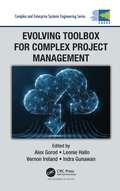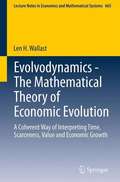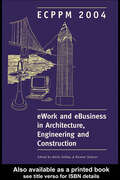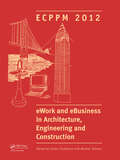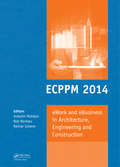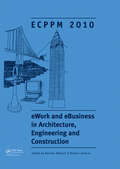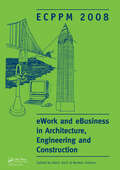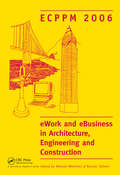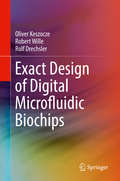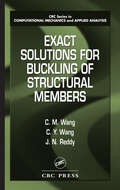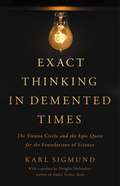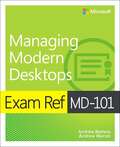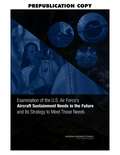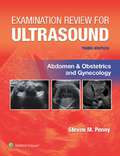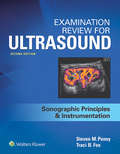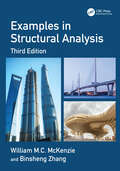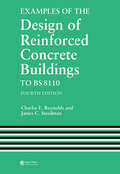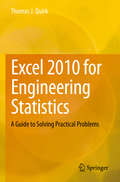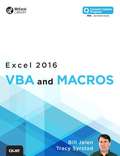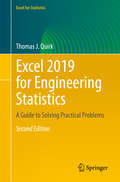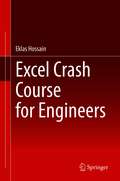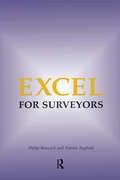- Table View
- List View
Evolving Toolbox for Complex Project Management (Complex and Enterprise Systems Engineering)
by Alex Gorod Vernon Ireland Indra Gunawan Leonie HalloThis book enhances learning about complex project management principles and practices through the introduction and discussion of a portfolio of tools presented as an evolving toolbox. Throughout the book, industry practitioners examine the toolsets that are part of the toolbox to develop a broader understanding of complex project management challenges and the available tools to address them. This approach establishes a dynamic, structured platform for a comprehensive analysis and assessment of the modern, rapidly changing, multifaceted business environment to teach the next generation of project managers to successfully cope with the ever increasing complexity of the 21st century.
Evolvodynamics - The Mathematical Theory of Economic Evolution
by Len H. WallastDissatisfied with the flaws of orthodox economics, the author proposes to base economic theory on the three principles of Darwinian evolution (variation, inheritance, selection). Pursuing a suggestion of E.T. Jaynes of 1991, the innovation is in treating economic behavior as chance events of selection. This involves abandoning the methods of mainstream economics and to apply instead the methods by which Claude E. Shannon analyzed information transport over a stationary channel. As economic processes are non-stationary, the author clarifies first how the Shannon-system must be reshaped in a system capable to describe economic evolution mathematically. As economic processes are non-stationary, the author first clarifies how the Shannon system must be reshaped into one capable of describing economic evolutions mathematically. Deriving the universal relations between input, output, the economic growth rate, inflation and money flow involves applying differential sets of selection, Venn diagrams, bitpulses as units of selection and the probability distributions of bitpulses. This is a thought-provocative and highly informative book of which the explanatory power goes far beyond that of traditional economics. It should be on the readers list of everyone concerned with the weal and woe of economic theorizing.
eWork and eBusiness in Architecture, Engineering and Construction: Proceedings of the 5th European Conference on Product and Process Modelling in the Building and Construction Industry - ECPPM 2004, 8-10 September 2004, Istanbul, Turkey
by Attila Dikbas Raimar SchererBiannually since 1994, the European Conference on Product and Process Modelling in the Building and Construction Industry has provided a review of research, given valuable future work outlooks, and provided a communication platform for future co-operative research and development at both European and global levels.This volume, of special interest t
eWork and eBusiness in Architecture, Engineering and Construction: ECPPM 2012
by Gudni Gudnason Raimar SchererSince 1994, the European Conferences of Product and Process Modelling (www.ecppm.org) have provided a review of research, development and industrial implementation of product and process model technology in the Architecture, Engineering, Construction and Facilities Management (AEC/FM) industry. Product/Building Information Modelling has matured sig
eWork and eBusiness in Architecture, Engineering and Construction: ECPPM 2014
by Ardeshir Mahdavi Bob Martens Raimar SchererIn the last two decades, the biannual ECPPM (European Conference on Product and Process Modelling) conference series has provided a unique platform for the presentation and discussion of the most recent advances with regard to the ICT (Information and Communication Technology) applications in the AEC/FM (Architecture, Engineering, Construction and
eWork and eBusiness in Architecture, Engineering and Construction: Proceedings of the European Conference on Product and Process Modelling 2010, Cork, Republic of Ireland, 14-16 September 2010
by Karsten Menzel Raimar SchererSince 1994, the European Conference on Product and Process Modelling has provided a discussion platform for research and development in Architecture, Engineering, Construction and Facilities Management sectors.eWork and eBusiness in Architecture, Engineering and Construction 2010 provides strategic knowledge on the achievements and trends in resear
eWork and eBusiness in Architecture, Engineering and Construction: Proceedings of the 12th European Conference on Product and Process Modelling (ECPPM 2018), September 12-14, 2018, Copenhagen, Denmark
by Raimar Scherer Jan KarlshojeWork and eBusiness in Architecture, Engineering and Construction 2018 collects the papers presented at the 12th European Conference on Product and Process Modelling (ECPPM 2018, Copenhagen, 12-14 September 2018). The contributions cover complementary thematic areas that hold great promise towards the advancement of research and technological development in the modelling of complex engineering systems, encompassing a substantial number of high quality contributions on a large spectrum of topics pertaining to ICT deployment instances in AEC/FM, including: • Information and Knowledge Management• Construction Management• Description Logics and Ontology Application in AEC• Risk Management• 5D/nD Modelling, Simulation and Augmented Reality• Infrastructure Condition Assessment• Standardization of Data Structures• Regulatory and Legal Aspects• Multi-Model and distributed Data Management• System Identification• Industrilized Production, Smart Products and Services• Interoperability• Smart Cities• Sustainable Buildings and Urban Environments• Collaboration and Teamwork• BIM Implementation and Deployment• Building Performance Simulation• Intelligent Catalogues and Services eWork and eBusiness in Architecture, Engineering and Construction 2018 represents a rich and comprehensive resource for academics and researchers working in the interdisciplinary areas of information technology applications in architecture, engineering and construction. In the last two decades, the biennial ECPPM (European Conference on Product and Process Modelling) conference series, as the oldest BIM conference, has provided a unique platform for the presentation and discussion of the most recent advances with regard to the ICT (Information and Communication Technology) applications in the AEC/FM (Architecture, Engineering, Construction and Facilities Management) domains.
eWork and eBusiness in Architecture, Engineering and Construction: ECPPM 2008
by Alain Zarli Raimar SchererSince 1994, the European Conference on Product and Process Modelling (www.ecppm.org) has been providing a review of research, development and industrial implementation of product and process model technology in construction. The 7th European Conference on Product and Process Modelling (ECPPM 2008) provided a unique discussion platform for topics of
eWork and eBusiness in Architecture, Engineering and Construction. ECPPM 2006: European Conference on Product and Process Modelling 2006 (ECPPM 2006), Valencia, Spain, 13-15 September 2006
by Manuel MartínezThe task of structuring information on built environment has presented challenges to the research community, software developers and the industry for the last 20 years. Recent work has taken advantage of Web and industry standards such as XML, OWL, IFC and STEP. Another important technology for the fragmented AEC industry is digital communication. Wired or wireless, it brings together architects, engineers and construction site workers, enabling them to exchange information, communicate and work together. Virtual enterprise organization structures, involving mobile teams over distance, are highly compatible with the needs of the construction industry.
Exact Design of Digital Microfluidic Biochips
by Oliver Keszocze Robert Wille Rolf DrechslerThis book presents exact, that is minimal, solutions to individual steps in the design process for Digital Microfluidic Biochips (DMFBs), as well as a one-pass approach that combines all these steps in a single process. All of the approaches discussed are based on a formal model that can easily be extended to cope with further design problems. In addition to the exact methods, heuristic approaches are provided and the complexity classes of various design problems are determined.Presents exact methods to tackle a variety of design problems for Digital Microfluidic Biochips (DMFBs);Describes an holistic, one-pass approach solving different design steps all at once;Based on a formal model of DMFBs that is easily adaptable to deal with further design tasks.
Exact Solutions for Buckling of Structural Members (Applied and Computational Mechanics)
by C.M. Wang C.Y. WangThe study of buckling loads, which often hinges on numerical methods, is key in designing structural elements. But the need for analytical solutions in addition to numerical methods is what drove the creation of Exact Solutions for Buckling of Structural Members. It allows readers to assess the reliability and accuracy of solutions obtained by nume
Exact Thinking in Demented Times: The Vienna Circle and the Epic Quest for the Foundations of Science
by Douglas Hofstadter Karl SigmundA dazzling group biography of the early twentieth-century thinkers who transformed the way the world thought about math and scienceInspired by Albert Einstein's theory of relativity and Bertrand Russell and David Hilbert's pursuit of the fundamental rules of mathematics, some of the most brilliant minds of the generation came together in post-World War I Vienna to present the latest theories in mathematics, science, and philosophy and to build a strong foundation for scientific investigation. Composed of such luminaries as Kurt Gödel and Rudolf Carnap, and stimulated by the works of Ludwig Wittgenstein and Karl Popper, the Vienna Circle left an indelible mark on science.Exact Thinking in Demented Times tells the often outrageous, sometimes tragic, and never boring stories of the men who transformed scientific thought. A revealing work of history, this landmark book pays tribute to those who dared to reinvent knowledge from the ground up.
Exam Ref Md-101 Managing Modern Desktops
by Andrew Bettany Andrew WarrenPrepare for Microsoft Exam MD-101-and help demonstrate your real-world mastery of skills and knowledge required to manage modern Windows 10 desktops. Designed for Windows administrators, Exam Ref focuses on the critical thinking and decision-making acumen needed for success at the Microsoft Certified Associate level. Focus on the expertise measured by these objectives: Deploy and update operating systems, Manage policies and profiles, Manage and protect devices, Manage apps and data. This Microsoft Exam Ref: Organizes its coverage by exam objectives; Features strategic; what-if scenarios to challenge you; Assumes you have experience deploying, configuring, securing, managing, and monitoring devices and client applications in an enterprise environment. About the Exam: Exam MD-101 focuses on knowledge needed to plan and implement Windows 10 with dynamic deployment or Windows Autopilot; upgrade devices to Windows 10; manage updates and device authentication; plan and implement co-management; implement conditional access and compliance policies; configure device profiles; manage user profiles; manage Windows Defender; manage Intune device enrollment and inventory; monitor devices; deploy/update applications, and implement Mobile Application Management (MAM). About Microsoft Certification: Passing this exam and Exam MD-100 Windows 10 fulfills your requirements for the Microsoft 365 Certified: Modern Desktop Administrator Associate certification credential, demonstrating your ability to install Windows 10 operating systems and deploy and manage modern desktops and devices in an enterprise environment.
Examination of the U.S. Air Force's Aircraft Sustainment Needs in the Future and Its Strategy to Meet Those Needs
by Air Force Studies BoardThe ability of the United States Air Force (USAF) to keep its aircraft operating at an acceptable operational tempo, in wartime and in peacetime, has been important to the Air Force since its inception. This is a much larger issue for the Air Force today, having effectively been at war for 20 years, with its aircraft becoming increasingly more expensive to operate and maintain and with military budgets certain to further decrease. The enormously complex Air Force weapon system sustainment enterprise is currently constrained on many sides by laws, policies, regulations and procedures, relationships, and organizational issues emanating from Congress, the Department of Defense (DoD), and the Air Force itself. Against the back-drop of these stark realities, the Air Force requested the National Research Council (NRC) of the National Academies, under the auspices of the Air Force Studies Board to conduct and in-depth assessment of current and future Air Force weapon system sustainment initiatives and recommended future courses of action for consideration by the Air Force. Examination of the U. S. Air Force's Aircraft Sustainment Needs in the Future and Its Strategy to Meet Those Needs addresses the following topics: Assess current sustainment investments, infrastructure, and processes for adequacy in sustaining aging legacy systems and their support equipment. Determine if any modifications in policy are required and, if so, identify them and make recommendations for changes in Air Force regulations, policies, and strategies to accomplish the sustainment goals of the Air Force. Determine if any modifications in technology efforts are required and, if so, identify them and make recommendations regarding the technology efforts that should be pursued because they could make positive impacts on the sustainment of the current and future systems and equipment of the Air Force. Determine if the Air Logistics Centers have the necessary resources (funding, manpower, skill sets, and technologies) and are equipped and organized to sustain legacy systems and equipment and the Air Force of tomorrow. Identify and make recommendations regarding incorporating sustainability into future aircraft designs.
Examination of the U.S. Air Force's Science, Technology, Engineering, and Mathematics (STEM) Workforce Needs in the Future and its Strategy to Meet Those Needs
by National Research Council of the National AcademiesThe Air Force requires technical skills and expertise across the entire range of activities and processes associated with the development, fielding, and employment of air, space, and cyber operational capabilities. The growing complexity of both traditional and emerging missions is placing new demands on education, training, career development, system acquisition, platform sustainment, and development of operational systems. While in the past the Air Force's technologically intensive mission has been highly attractive to individuals educated in science, technology, engineering, and mathematics (STEM) disciplines, force reductions, ongoing military operations, and budget pressures are creating new challenges for attracting and managing personnel with the needed technical skills. Assessments of recent development and acquisition process failures have identified a loss of technical competence within the Air Force (that is, in house or organic competence, as opposed to contractor support) as an underlying problem. These challenges come at a time of increased competition for technical graduates who are U.S. citizens, an aging industry and government workforce, and consolidations of the industrial base that supports military systems. In response to a request from the Deputy Assistant Secretary of the Air Force for Science, Technology, and Engineering, the National Research Council conducted five fact-finding meetings at which senior Air Force commanders in the science and engineering, acquisition, test, operations, and logistics domains provided assessments of the adequacy of the current workforce in terms of quality and quantity.
Examination Review for Ultrasound: Abdomen And Obstetrics And Gynecology
by Steven PennyThis updated 2nd Edition of Examination Review for Ultrasound: Abdomen & Obstetrics and Gynecology helps students prepare for—and excel on—the ARDMS and ARRT certification exams. Focusing on only the information needed for exam success, this proven resource includes a concise, narrative approach, content based on the current exam, and an online exam simulator with registry-style questions.
Examination Review for Ultrasound: Abdomen and Obstetrics & Gynecology
by Steven M. PennyPrepare for—and excel on—the American Registry for Diagnostic Medical Sonography (ARDMS) and American Registry of Radiologic Technologists (ARRT) certification exams! Steven M. Penny’s Examination Review for Ultrasound: Abdomen & Obstetrics and Gynecology, 3rd Edition, focuses only on the information that you’ll see on these exams, saving you valuable study time. Now in full color throughout, it uses a concise, narrative approach and features an online exam simulator with hundreds of registry-style questions.
Examination Review for Ultrasound: Sonographic Principles And Instrumentation (spi)
by Steven Penny Traci FoxThis updated 2nd Edition of Examination Review for Ultrasound: Sonographic Principles & Instrumentation helps students prepare for—and excel on— the Sonography Principles and Instrumentation (SPI) certification examination offered by the ARDMS. Taking a concise, narrative approach, this proven resource aligns with the SPI revised content outline and format. An online exam simulator with registry-style questions makes it easy to create mock exams that allow unlimited practice.
Examples in Structural Analysis
by William M.C. McKenzie Binsheng ZhangThis third edition of Examples in Structural Analysis uses a step-by-step approach and provides an extensive collection of fully worked and graded examples for a wide variety of structural analysis problems. It presents detailed information on the methods of solutions to problems and the results obtained. Also given within the text is a summary of each of the principal analysis techniques inherent in the design process and where appropriate, an explanation of the mathematical models used. The text emphasises that software should only be used if designers have appropriate knowledge and understanding of the mathematical assumptions, modelling and limitations inherent in the programs they use. It establishes the use of hand-methods for obtaining approximate solutions during preliminary design and an independent check on the answers obtained from computer analysis. What is New in the Third Edition: A new chapter covers the analysis and design of cables and arches subjected to concentrated loads and uniformly distributed loads. For cables without or with simply supported pinned trusses or steel girder beams through equally spaced hangers, tension forces, support reactions, sags and slopes in cables are determined. For two-pinned or three-pinned arches with parabolic, arched and semi-circular shapes, axial forces, radial shear forces and bending moments at various sections of arches are determined. An existing chapter has been expanded to the construction and use of influence lines for pin-pointed trusses and lattice girders. Also, the chapter Direct Stiffness Methods has been revisited and amended.
Examples of the Design of Reinforced Concrete Buildings to BS8110
by C.E. Reynolds J.C. SteedmanThe latest edition of this well-known book makes available to structural design engineers a wealth of practical advice on effective design of concrete structures. It covers the complete range of concrete elements and includes numerous data sheets, charts and examples to help the designer. It is fully updated in line with the relevant British Standards and Codes of Practice.
Excel 2013 for Engineering Statistics
by Thomas J. QuirkThis is the first book to show the capabilities of Microsoft Excel to teach engineering statistics effectively. It is a step-by-step exercise-driven guide for students and practitioners who need to master Excel to solve practical engineering problems. If understanding statistics isn't your strongest suit, you are not especially mathematically-inclined, or if you are wary of computers, this is the right book for you. Excel, a widely available computer program for students and managers, is also an effective teaching and learning tool for quantitative analyses in engineering courses. Its powerful computational ability and graphical functions make learning statistics much easier than in years past. However, Excel 2013 for Engineering Statistics: A Guide to Solving Practical Problems is the first book to capitalize on these improvements by teaching students and managers how to apply Excel to statistical techniques necessary in their courses and work. Each chapter explains statistical formulas and directs the reader to use Excel commands to solve specific, easy-to-understand engineering problems. Practice problems are provided at the end of each chapter with their solutions in an Appendix. Separately, there is a full Practice Test (with answers in an Appendix) that allows readers to test what they have learned.
Excel 2016 VBA and Macros
by Bill Jelen Tracy SyrstadUse this guide to automate virtually any routine task: save yourself hours, days, maybe even weeks! Make Excel do things you thought were impossible, discover macro techniques you won’t find anywhere else, and create automated reports that are amazingly powerful. Bill Jelen and Tracy Syrstad help you instantly visualize information, so you can act on it… capture data from anywhere, and use it anywhere… automate Excel 2016’s best new features. You’ll find simple, step-by-step instructions, real-world case studies, and 50 workbooks packed with bonus examples, macros, and solutions–straight from MrExcel!
Excel 2019 for Engineering Statistics: A Guide to Solving Practical Problems (Excel for Statistics)
by Thomas J. QuirkNewly revised to specifically address Microsoft Excel 2019, this book shows the capabilities of Excel in teaching engineering statistics effectively. Similar to the previously published Excel 2016 for Engineering Statistics, this volume is a step-by-step, exercise-driven guide for students and practitioners who need to master Excel to solve practical engineering problems.Excel, a widely available computer program for students and professionals, is also an effective teaching and learning tool for quantitative analyses in engineering courses. Its powerful computational ability and graphical functions make learning statistics much easier than in years past. Excel 2019 for Engineering Statistics capitalizes on these improvements by teaching readers how to apply Excel to statistical techniques necessary in their courses and work.Each chapter explains statistical formulas and directs the reader to use Excel commands to solve specific, easy-to-understand engineering problems. Practice problems are provided at the end of each chapter with their solutions in an appendix. Separately, there is a full practice test (with answers in an appendix) that allows readers to test what they have learned. This new edition features a wealth of new sample problems and solutions, as well as updated chapter content throughout.
Excel Crash Course for Engineers
by Eklas HossainExcel Crash Course for Engineers is a reader-friendly introductory guide to the features, functions, and applications of Microsoft Excel in engineering. The book provides readers with real-world examples and exercises that are directly related to engineering, and offers highly illustrated, step-by-step demonstrations of techniques to solve and visualize engineering problems and situations. The book includes an introduction to MS Excel, along with in-depth coverage of graphing and charting, functions and formulae, Excel's Visual Basic for Applications (VBA) programming language, and engineering data analysis. This powerful tutorial is a great resource for students, engineers, and other busy technical professionals who need to quickly acquire a solid understanding of Excel.
Excel for Surveyors
by Philip Bowcock Natalie BayfieldThis book is an introduction to Microsoft Excel™ concentrating on the program's unique application to the work of surveyors. Useful operations such as the creation of valuation tables and automation of conventional valuations are explained with the aid of step by step examples and screen-shots. The setting up of discounted cash flow problems and development appraisals are given special attention, and specific problems posed by over-rented property and leaseholds are also considered, additionally the book includes examples of database and chart functions useful to management and agency surveyors
